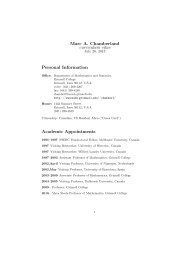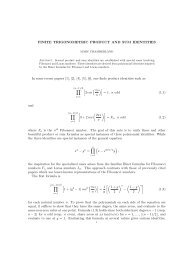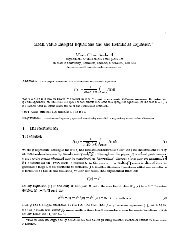An Update on the 3x+1 Problem Marc Chamberland Contents
An Update on the 3x+1 Problem Marc Chamberland Contents
An Update on the 3x+1 Problem Marc Chamberland Contents
You also want an ePaper? Increase the reach of your titles
YUMPU automatically turns print PDFs into web optimized ePapers that Google loves.
12<br />
and Lagarias[8](1995). The functi<strong>on</strong>s e l (k, ·) are integrable with respect to Z ∗ 3 ’s<br />
unique normalized Haar measure, yielding <strong>the</strong> 3-adic average<br />
⎛ ⎞<br />
∫<br />
1<br />
ē l (k) := e l (k, a)da = ⎝ k + l ⎠<br />
2 · 3 l−1 .<br />
l<br />
Several results follow with this approach, including<br />
∫<br />
1<br />
lim inf<br />
n→∞ 2 n s n (a)da > 0,<br />
Z ∗ 3<br />
Z ∗ 3<br />
implying that every predecessor set P T (a) with a ≢<br />
density.<br />
0 mod 3 has positive<br />
3 Representati<strong>on</strong>s of Iterates of a 3x + 1 Map<br />
The oft-cited result in this area is due to Böhm and S<strong>on</strong>tacchi[14](1978): <strong>the</strong><br />
3x + 1 problem is equivalent to showing that each n ∈ Z + may be written as<br />
(<br />
)<br />
n = 1<br />
m−1<br />
∑<br />
3 m 2 vm − 3 m−k−1 2 v k<br />
where m ∈ Z + and 0 ≤ v 0 < v 1 < · · · v m are integers. Similar results were<br />
obtained by Amigó[2, Prop.4.2](2001).<br />
k=0<br />
Sinai[70](2003) studies <strong>the</strong> functi<strong>on</strong> F <strong>on</strong> <strong>the</strong> set ⊓ defined as<br />
⊓ = {1} ∪ ⊓ + ∪ ⊓ − , ⊓ ±1 = 6Z + ± 1.<br />
Let k 1 , k 2 , . . . , k m ∈ Z + and ɛ = ±1. Then <strong>the</strong> set of x ∈ ⊓ ɛ to which <strong>on</strong>e can<br />
apply F (k1) F (k2) · · · F (km) is an arithmetic progressi<strong>on</strong><br />
σ (k1,k2,...,km,ɛ) = {6 · (2 k1+k2+···+km + q m ) + ɛ}<br />
for some q m such that 1 ≤ q m ≤ 2 k1+k2+···+km . Moreover,<br />
F (k1) F (k2) · · · F (km) (σ (k1,k2,...,km,ɛ) ) = {6 · (3 m p + r) + δ}<br />
for some r and δ satisfying 1 ≤ r ≤ 3 m , δ = ±1. Results in this spirit may<br />
be found in <str<strong>on</strong>g>An</str<strong>on</strong>g>drei et al.[5](2000) and Kuttler[44](1994). Sinai uses this result





